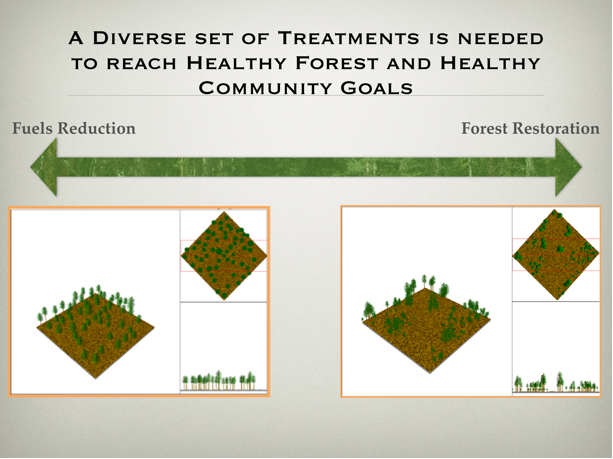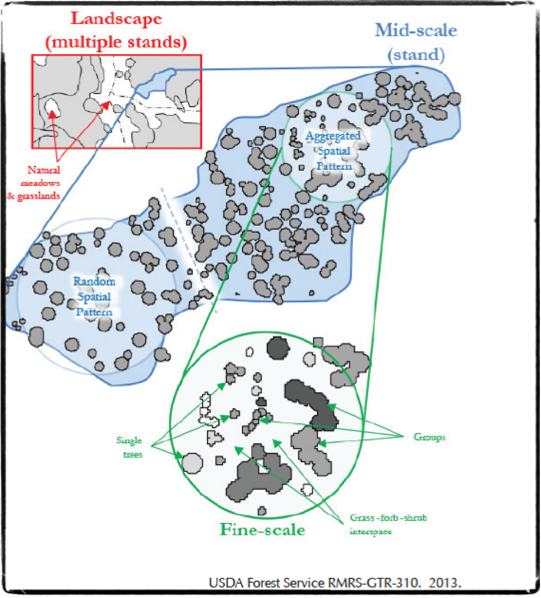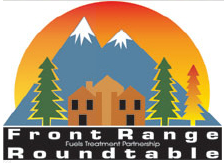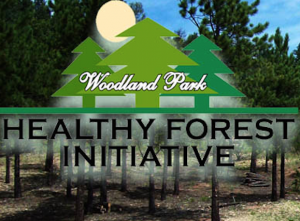
Human activities and changes in land use have created unnatural forest conditions in which trees, plants, and wildlife don’t have the right balance of nutrients, sunlight, water, and space to thrive. Development has encroached upon forests and has changed the historical role that fire once played within our unique ecosystem and has skewed the balance that the landscape and fire once had. CUSP uses a balanced approach to forest management, considering local ecosystem function, stakeholder desires, and fire risk management. This approach is essential when working with diverse interests.
Forest Management Approach
Our overarching goals and objectives of our forest management activities are:
- Improve forest health: Forest health is a nebulous term at best. However, with a more specific description we can define aspects of forest health, such as disturbance resilience and/or resistance, amongst others. In this forest, management will focus on leveraging resistance to low intensity fire in a frequent surface fire regime, while encouraging resilience to disturbances such as fire, insects, disease and storm damage by having a balance of age classes distributed in distinct and randomly separated groups with the creation of a continuous network of openings and meadows. The creation of the continuous network of openings and promoting a balance of age and size classes that are spatially distinct from each other is central to this objective.
- Reduce hazardous fuels: Working off of the forest health objective, management involves reducing hazardous fuels, or living or dead vegetation that is flammable. Employing forest restoration treatments to reduce total stems per acre by creating a network of openings and aggregating residual stems into a mosaic of groups can reduce the size, severity, and extent of potential future wildfires. This strategy segregates fuels into single groups and does not allow for horizontal and vertical fuel continuity through the treatment area.
- Enhance wildlife habitat: Further employing the forest health and hazardous fuels objectives, we promote an uneven age and size class structure. A balance of age classes must be in variable distance and proximity to one another, while maintaining continuous and connected openings between aggregates that create randomly distributed, variably shaped groups of trees that are on average between 0.5 and 1.5 of the tallest tree length to the next group. In this food web-based approach, it is critical that crowns are either interlocking, or close (within 5 feet) to interlocking, within groups. This approach creates multiple habitats for a suite of wildlife species that use many different forest structures in relative close proximity to one another.
- Mitigate insects and disease: Grouping trees in a mosaic pattern encourages adequate distances between groups and random distribution of age class aggregates that are more resilient to disease and insects. For example, groups that are on average spaced further than the average maximum dispersal of dwarf mistletoe (<45 feet), will keep infected mistletoe trees to individual groups and not spread as quickly as evenly spaced trees. Additionally, young trees, mid-aged trees, and old trees randomly arranged by openings will better resist mountain pine beetle, and if successfully attacked, can be readily mitigated by group selection and removal. With respect to mountain pine beetle and other insects, if successful broods are developed in a single group, the random distribution of groups in the area will further disperse the beetle and provide a sufficient number of younger age classes to replenish the age class structure.
- Enhance recreation and aesthetics: Many people use the land for hiking, wildlife viewing, forest products, and other place-based activities. The approach to address generalized forest health concerns, with the need to reduce hazardous fuels and address insect and disease control, will improve wildlife habitat in a way that enhances the opportunity for visitors to engage with their land in more and new ways. The end result will be a aesthetic enhancement that will NOT have a “jail bar” look of evenly spaced trees of a single age that is more typical of traditional fuels treatments and shelterwood silvicultural treatments.
This balanced approach to forest management allows us to effectively reduce wildfire risk and create healthier forest and human communities. We call this the Continuum of Management.

In this continuum of treatment we use the best available science to dictate management techniques, treatments, and objectives. This scale, from fuels reduction to forest restoration, is intended to allow CUSP to work at varying levels upon the landscape. It is important to understand that risk reduction will vary within this scale of treatment. That is to say, the lighter approach (fuels reduction) has a higher risk for future fires, and the more intensive approach (forest restoration) results in less risk when the next fire starts.
Fuels Reduction
Under the fuels reduction management alternative, there will be uniform thinning primarily from below to meet Colorado State Forest Service shaded fuel break guidelines.
The prescription for a shaded fuel break is to:
- Reduce basal area (the average area occupied by trees) from 113 square ft2/acre to 40-30 ft2/acre (about a 70% reduction) across all species
- Focus on all intermediate and suppressed trees in understory,
- Select overstory trees
- Maintain an average of 25 feet between crowns
- Focus on retention of ponderosa pine in all size classes
The benefits of the shaded fuel break are eliminating ladder fuels and reducing opportunities for potential ground fires to reach the canopy. This allows managers a relatively easy approach to tree selection and promoting uniform treatment.
The concerns related to the shaded fuel breaks approach include a focus on residual trees that are likely not wind firm, resulting in wind-throw. Spacing requirements are also a problem. Spacing between overstory trees must be at the very least 35 feet between crowns due to slope. This spacing provides little to no cover for wildlife, and can give the appearance of evenly spaced cornrows. The shaded fuel break approach likely only reduces the threat from low intensity ground fires in low wind conditions. High wind events could carry fire from treetop to treetop because spacing is uniform.
If you would like fuels reduction done on your property or in your HOA/community contact CUSP to begin the process.
Forest Restoration
When undertaking forest restoration, we seek to:

- Reduce basal area from the average 105 ft2/acre to between 50 and 60 ft2/acre (about a 50% reduction)
- Focus on a more random arrangement of single trees and even-age and size groups that have interlocking crowns and range in 1/100th/acre (435 ft2) to 1/5th/acre (8,700 ft2) area of full retention
- Treat so the average distance between groups is 30-80 feet
- Focus on retention of groups of ponderosa pine regeneration and older and larger age and size classes
- Focus on removing the 10-inch size class of ponderosa pine
The major benefit of the forest restoration approach is the spatial outlay of forest restoration prescription lends itself to a forest that will be on a more effective and sustainable successional trajectory. Because of its spatially random mosaic of uneven clumps, it will provide an enhanced and sustainable opportunity for value added concerns such as improved wildlife habitat and aesthetics. Potential for crown fire running is reduced dramatically by creating large openings between single trees and clumps.
The major concern related to forest restoration is this is the most complex marking and management approach. It is time-intensive and care must be taken to verify a more spatially random structure is achieved while ensuring benefits can be realized. It is much more likely that high severity crown fire can burn within groups because there is potential vertical and certain horizontal fuel continuity within groups. However, crown fire will be passive as it will be isolated from adjacent groups and single trees. This alternative necessitates more frequent maintenance, and a growing need to maintain the desired condition in this case may require the use of prescribed fire.
Learn more about ecological restoration in the Benefits of Forest Restoration Literature Review.
Getting Work Done
Forests and wildfires do not recognize property boundaries, so we work with landowners and land management agencies to plan and execute forest health projects on public and private lands to improve forest health on a landscape scale. Our forester and trained crew base forest prescriptions on ecological indicators, and take wildfire and habitat considerations into account when carrying out forest health projects. We prioritize projects in areas with high values, such as forested areas around communities, water supplies, and recreation areas.
How do we do this? CUSP uses a diverse set of tools to achieve our forest management objectives. Each tool is suitable for certain projects, and has benefits and limitations. Forest treatment types and approaches include:
- Conventional cut and remove: Trees are selectively cut down and removed from the forest. Which trees are cut is determined by the objectives of the project.
- Cut and chip: Trees are selectively cut down and chipped onsite. Chipped biomass from the cut trees is then spread evenly on the forest floor.
- Lop and scatter: Trees are selectively cut down, and branches, tops, and trunk segments are cut up and spread evenly over the ground.
- Mastication: Trees are selectively cut down, then processed into smaller pieces by grinding, shredding, or chopping with heavy equipment. See a video of mastication in action.
Wood Utilization
As we continue to undertake forest projects, we have an abundance of forest by-products and logs. It is essential that we utilize this material in whatever way we can. Here are a few of the ways the CUSP uses the material that we create:
- Firewood: We provide firewood to be used in stoves and fireplaces for heating through organizations like Help the Needy. Find Environmental Protection Agency-certified stoves and fireplaces. You should always burn local firewood so as not to transport diseases and insect infestations.
- Fence rails: We used felled trees to build buck and rail fences to protect sensitive areas.
- Saw logs and architectural features: Biomass from forestry projects can be processed into products for use in buildings and infrastructure. Learn more about the use of wood in architectural features.
- Biomass to energy: Wood is a renewable energy source and is being utilized more and more in biomass to energy processes in Colorado. The Gypsum Biomass Plant, Evergreen Clean Energy, and the Fairplay School provide models for using biomass for energy. Wood2Energy and the Colorado Wood Utilization and Marketing Program also provide a wealth of resources for using biomass.
- Pile Burning: The CUSP crew, as part of our commitment to forest restoration, is certified to conduct pile burning in the watershed. There are many misconceptions about how to build piles. See: Colorado Pile Manual for more information, also read this study of burn pile construction as it relates to forest health: Slash From the Past
Ecological restoration and wildfire mitigation are significantly more effective when working together. Support healthy and resilient forests today by:
- Utilizing available wildfire mitigation resources
- Contacting us to get started with mitigation on your property and in your community
Feature Projects:
Woodland Park Healthy Forest Initiative (WPHFI)
The WPHFI is a partnership of key stakeholders from the Woodland Park area. The objective is to thin dense ponderosa pine stands surrounding the community in order to make the area more resilient to catastrophic wildfire. These forest treatments not only make the forest more resilient to catastrophic wildfire, but also improve the health of individual trees, making them more resistant to bark beetle infestation, and more resilient to drought. As an additional benefit, the WPHFI is endeavoring to remove and chip as much of the slash as possible, then utilize this woody biomass as a source of renewable energy.

Bailey Healthy Forest Initiative (BHFI)
The BHFI is a partnership of key stakeholders from the Bailey area working to improve the health of the forest surrounding the community. Forest treatments not only make the forest more resilient to catastrophic wildfire, but also improve the health of individual trees, making them more resistant to bark beetle infestation, and more resilient to drought. Find out more and get involved at www.baileyhealthyforests.org
Upper Monument Creek Landscape Restoration Initiative
The Upper Monument Creek Landscape Restoration Initiative began in 2012 to accelerate forest restoration in a high priority area in the Pike National Forest. The initiative is a highly collaborative project focused on developing science-based restoration and management recommendations for the Upper Monument Creek landscape that will improve ecological resilience, protect watershed resources, and reduce community wildfire risks. The focus area of the initiative encompasses 67,000 acres in Colorado’s southern Front Range. While this initiative focuses on federal lands, CUSP is actively engaging private communities and residents adjacent to federal lands where work is slated to occur. Find out more at www.conservationgateway.org
 Front Range Roundtable Collaborative Forest Landscape Restoration Program
Front Range Roundtable Collaborative Forest Landscape Restoration Program
The Colorado Front Range Landscape Restoration (CFLRP) project is intended to accelerate ongoing restoration treatments that provide long-lasting ecological, social and economic benefit across a 1.5 million-acre landscape covering parts of the Arapaho and Roosevelt and Pike and San Isabel National Forests in Colorado. This project will facilitate additional treatment of approximately 32,000 high-priority acres on National Forest System (NFS) lands within the Roundtable’s designated 800,000-acre restoration zone and will be enhanced by existing and future treatments on adjacent federal and non-federal lands. A large portion of the 800,000 acre restoration zone is within the wildland urban interface and will be the focus of the 32,000 acres of treatment. Find out more


